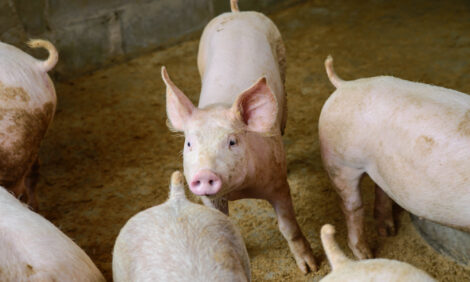



Past, Present and Future of Sow Housing at GDPIA Trade Show
CHINA - Mr. Shi Jing Cheng, Osborne Livestock Technology Company, presented information on the past, present and future trends of sow housing in North America at the Guangdong Pig Industry Association (GDPIA) Trade Show June 16, 2009.
The show, held in Guangzhou, Guangdong Province,
China, was attended by approximately 2,000
hog producers.
The GDPIA trade show is held biannually in June and December. Educational symposiums, similar to the presentation given by Mr. Shi Jing Cheng, provide swine producers with educational seminars and information on new production techniques and technology for swine production. The Chinese government is encouraging pork producers to focus on improving breeding results as pork is the staple meat of the country. Additionally, a trade show, sponsored by the Guangdong Pig Association, a government agency, provides a platform for agricultural companies to exhibit their latest products and innovations.

Mr. Shi’s presentation included information about Osborne Industries’ experience with electronic sow
management in group settings and its benefits versus housing sows in individual crates. In the 1990’s,
the method of housing sows in North America experienced a transition from an outdoor, group setting
to indoor, individual crates. The construction of large-scale swine production facilities in the mid-1990’s
prompted companies to use single animal gestation crates in order to increase performance and use labor
more efficiently. Recently, however, many countries around the world, including some states in the U.S.,
passed legislation banning the use of gestation crates. In 2007, large North American-based corporate
producers made public their decision to start moving toward the use of electronic sow management systems
in group settings.
Seven of the fifty states in the United States have banned gestation stalls and recent activity by animal rights activist groups indicates additional states will continue to follow this trend. On January 1, 2013, the European Union ban on gestation stalls after thirty days of gestation goes into effect. All these events point to the move away from gestation stalls to group housing. Countries that intend to remain in a global market must consider these changes.
Several group housing systems are available, such as dump feeding, trickle feeding, free access stalls, or electronic sow feeding, but only one system enables producers to feed the right amount of feed to the right sow at the right time and precisely manage sows. The Total Electronic Animal Management (TEAM®) system from Osborne Industries provides precise control of sow management and information necessary for producers to make informed decisions. Osborne Industries has been involved with group sow housing for over 20 years and recognizes it as a more effective way to manage sows.
The GDPIA trade show is held biannually in June and December. Educational symposiums, similar to the presentation given by Mr. Shi Jing Cheng, provide swine producers with educational seminars and information on new production techniques and technology for swine production. The Chinese government is encouraging pork producers to focus on improving breeding results as pork is the staple meat of the country. Additionally, a trade show, sponsored by the Guangdong Pig Association, a government agency, provides a platform for agricultural companies to exhibit their latest products and innovations.

Seven of the fifty states in the United States have banned gestation stalls and recent activity by animal rights activist groups indicates additional states will continue to follow this trend. On January 1, 2013, the European Union ban on gestation stalls after thirty days of gestation goes into effect. All these events point to the move away from gestation stalls to group housing. Countries that intend to remain in a global market must consider these changes.
Several group housing systems are available, such as dump feeding, trickle feeding, free access stalls, or electronic sow feeding, but only one system enables producers to feed the right amount of feed to the right sow at the right time and precisely manage sows. The Total Electronic Animal Management (TEAM®) system from Osborne Industries provides precise control of sow management and information necessary for producers to make informed decisions. Osborne Industries has been involved with group sow housing for over 20 years and recognizes it as a more effective way to manage sows.








